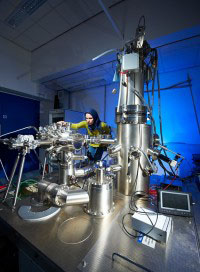
Graphene is an amazing material offering high strength, transparency, and flexibility with excellent electrical and thermal conductivity, all from a single layer of carbon atoms. To further understand and research all the possibilities of graphene, the Graphene Center Laboratory was opened at the University of Bath On May 1st.
Forty times stronger than steel and conducting electricity ten times better than silicon, graphene is the wonder material that could one day replace silicon in microchips. Now the University is opening a new Graphene Center Laboratory that will study its amazing properties and develop its potential applications.
Graphene could be used to develop faster electronic devices, for example, more advanced mobile phones and super-fast computers, flexible touch screens, and medical sensor devices.

The new laboratory, officially opened by our Vice-Chancellor Professor Dame Glynis Breakwell on Tuesday, May 1, forms part of the Center for Graphene Science, which brings together expertise at the Universities of Bath and Exeter.
Professor Simon Bending from the University’s Department of Physics said: “Graphene is a remarkable material made of a single layer of carbon atoms. Combining high strength, transparency, and flexibility with excellent electrical and thermal conductivity, it has many potential applications.”
The new laboratory at Bath is home to a range of state-of-the-art equipment, including a specially adapted scanning probe microscope – nicknamed the “nano-factory” – that can build new materials and create rapid prototypes of novel devices that have never been made before.
Dr. Adelina Ilie, Lecturer in Physics, on whose research the instrument is based, explained: “The nano-factory works like a tiny stencil, which can spray patterns of different materials onto a layer of graphene. This allows us to build new types of devices directly onto graphene, layer by layer, to directly probe and exploit its unique properties.”
Dr. Peter Sloan, Lecturer in Physics added: “With the nano-factory, we can also build up bespoke atomic-scale structures one atom at a time to link with the stenciled devices, making our new microscope world-leading.
“Not only will we make prototypes of unique graphene-based devices, but we can also really play around with some exciting fundamental physics.”
Researchers will also use the new Graphene Center Laboratory to investigate the extraordinary properties of carbon nanotubes, rolled sheets of graphene some 50,000 times narrower than a human hair.
Dr. Ilie has combined nanotubes with other elements to make hybrid carbon nanomaterials that are electronically patterned like striped candy canes; the stripes are so narrow that electrons are “guided” along them, suggesting they could be used as electronic connections in a quantum computer.
Dr. Ilie said: “This new laboratory will enable us to investigate the huge potential applications of graphene and carbon nanotubes – the sky’s the limit!”
The Center for Graphene Science has been funded by strategic investments by the Universities of Bath and Exeter into materials research, and by a £5 million award from the EPSRC/HEFCE Science and Innovation Awards Scheme 2008.